 Copyright © Michael Richmond.
This work is licensed under a Creative Commons License.
Copyright © Michael Richmond.
This work is licensed under a Creative Commons License.
Our Sun: the view from outside
Okay, obvious things first:
- The Sun is hot. Really hot.
The visible "surface" of the Sun, called the photosphere,
has a temperature of about 5800 Kelvin.
That's equivalent to roughly 10,000 Fahrenheit.
Any solid substance placed in the photosphere would
rapidly melt and evaporate into gas.
- The Sun is big. Really big.
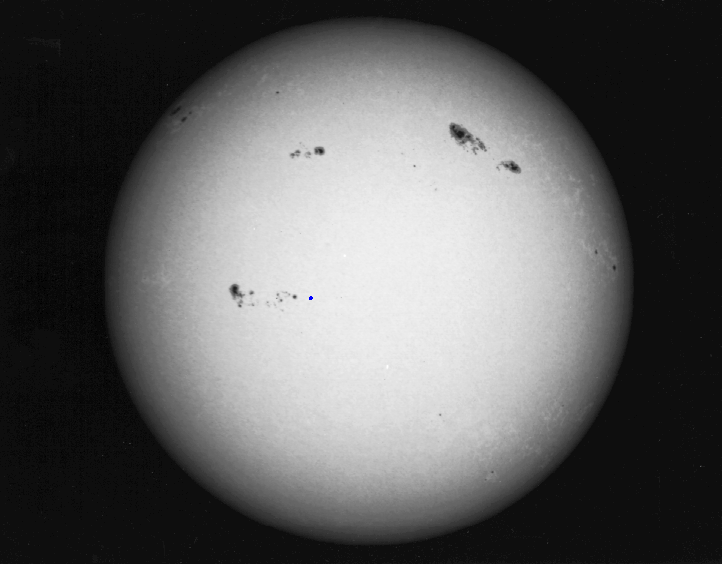
See that little blue dot near the center, just to the right
of the large sunspot group?
That's how big the Earth would be if it were sitting in front
of the Sun.
You can get a rough idea for the size of the Sun by using a little
geometry -- exactly the same geometry you would use for parallax:
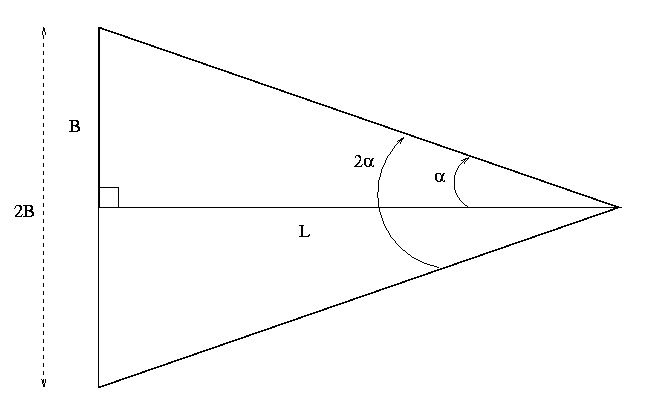
Q: The Sun subtends an angle of about one-half of
one degree, as seen from the Earth.
What is the average distance between Sun and Earth?
What is the radius of the Sun?
If you want the exact numbers, for the Sun or any major
body in the solar system, I recommend
The Nine Planets WWW site.
But there's more to see,
if one looks very closely, and especially if one
looks with different eyes.
Sunspots
If one examines the photosphere with a big optical telescope
from a site with very clear and steady air,
one notices several features:
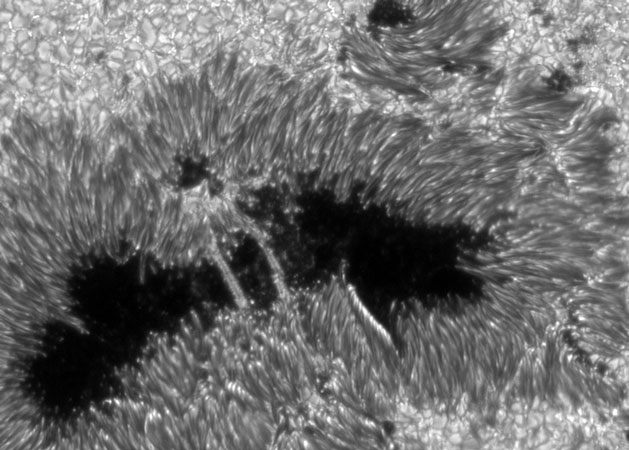
Dark spots appear scattered over the photosphere.
These sunspots
are regions in which the temperature is just a little
bit cooler than the surroundings:
roughly 4000 K, versus 5800 K.
Because they are cooler, they emit less radiation,
and therefore look, well, darker than the hot gas around them.
Q: Sunspots emit roughly ________ as much
light as the surrounding photosphere.
8% 23% 48% 69%
If you watch the Sun over a period of several weeks, you
can see the sunspots move across its disk.

Strangely enough, spots near the Sun's equator make one
complete revolution faster than those near the Sun's poles.
How can that happen?
It can't on a solid body, like the Earth,
but there's no problem if the body is gaseous.
Don't forget: we don't see the SURFACE of the Sun,
we see its OUTER ATMOSPHERE.
Why are sunspots cooler than the rest of the photosphere?
The answer has something to do with magnetic fields.
Because different portions of the Sun rotate at different
rates, the large-scale magnetic field of the Sun
gets tangled up, like an unruly ball of string.
Occasionally,
a section of the field pops up from below the photosphere,
arcs gracefully above the surface, and dives back
down.
Where it cuts through the photosphere, we see a sunspot.
The strong magnetic fields near sunspots force
gas to flow along the field lines, making tube-like
structures called spicules:
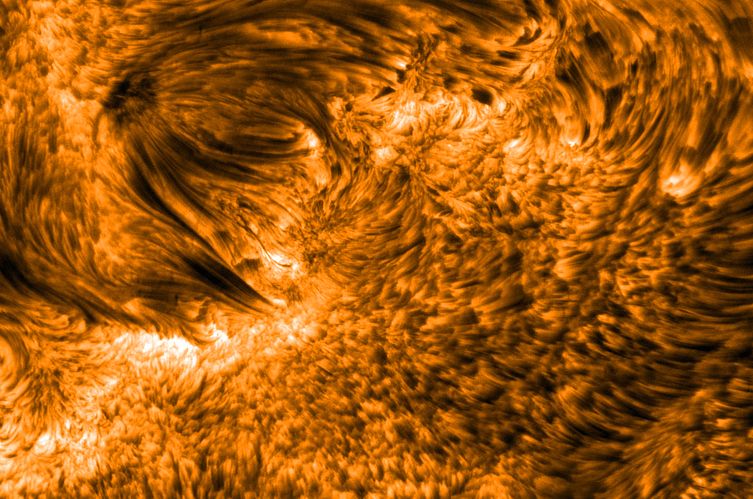
Credit:
SST,
Royal
Swedish Academy of Sciences,
LMSAL
This picture of a sunspot pair near the limb of the Sun
was recorded by the
TRACE spacecraft.
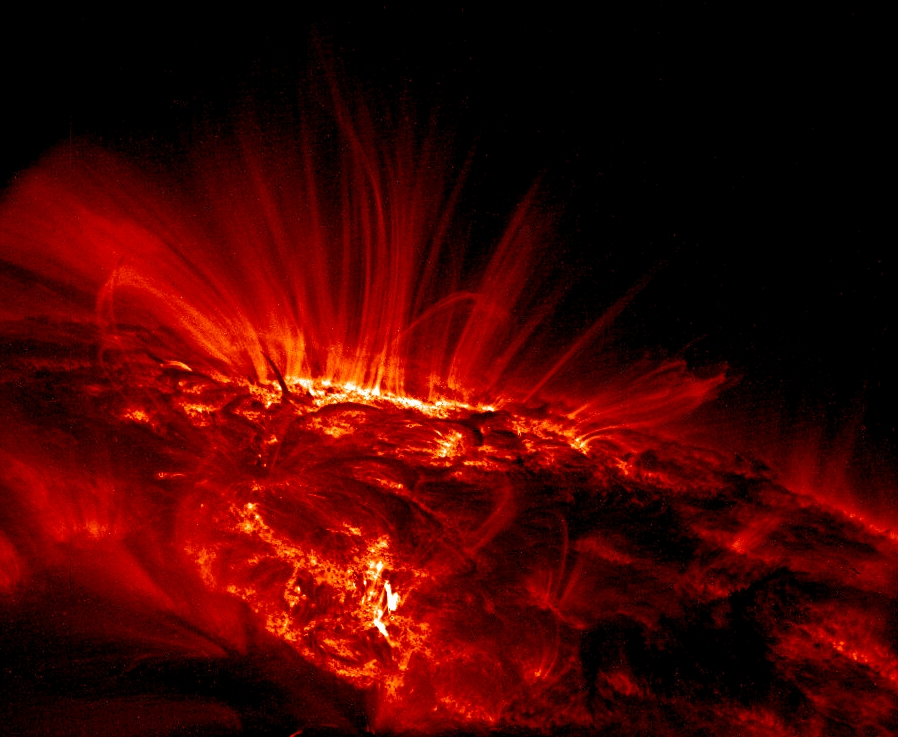
In this ultraviolet image,
gas at the level of the photosphere is dark,
indicating a temperature of thousands of degrees.
But flowing high above the photosphere, along the lines
of the magnetic field,
gas is heated (somehow) to temperatures of over one
million degrees.
It emits ultraviolet and X-ray radiation.
Q: If the gas above sunspots is so much hotter,
it should emit more radiation than the cool
gas below. So why do sunspots appear dark?
Granulation
The photosphere is a dynamic place even far
from sunspots.
High-resolution photographs show that the
gas isn't a uniform brightness,
but broken up into "little" cells called
granules.
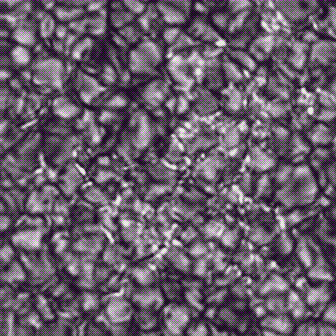
The granules "boil", exactly like water in a hot pot --
-- and for exactly the same reason: convection.
Here's how it works:
the interior of the Sun heats up gas in the photosphere.
A hot blob of gas expands a bit and becomes slightly
less dense than its surroundings.
As a result, it rises upwards, like a hot-air balloon.
Eventually, after radiating its heat into space,
the gas cools off, and falls back down towards the
interior.
The chromosphere
The Sun's atmosphere becomes less dense as one moves outwards
and upwards.
Above the photosphere is a layer called the
chromosphere.
The gas here is hotter than that in the photosphere,
probably because of energy transferred to the gas
by strong areas in the Sun's magnetic field.
In this simultaneous pair of images,
which show the same portion of the Sun's photosphere (top)
and chromosphere (bottom),
note how much brighter -- hotter -- the gas in the
chromosphere is over the sunspot groups.
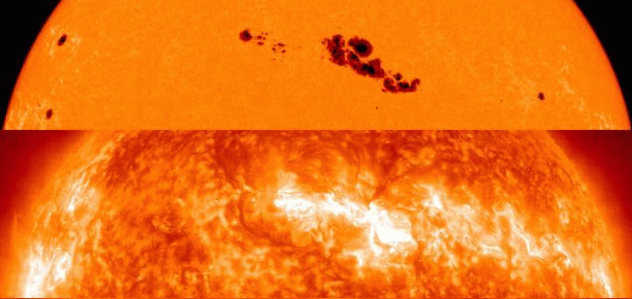
As light from the photosphere flies out into space,
some of it is absorbed by atoms in the chromosphere.
The dark lines in the solar spectrum are created in this
region of the solar atmosphere,
which gives us more information about this thin layer
than any other portion of the Sun.
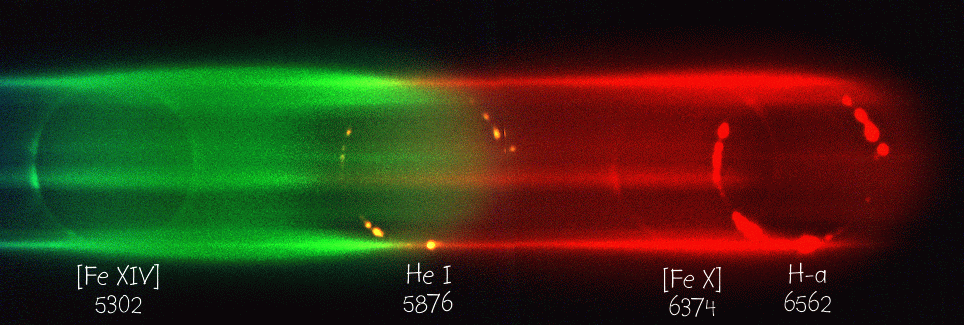
Taken by the Fosbury team during the solar eclipse, 11 Aug 1999.
Back in the nineteenth century, astronomers studying the
optical spectrum of the Sun found several lines
which did not correspond to any elements tested in
their laboratories.
One of these lines, in the yellow portion of the spectrum,
was especially bright in prominences and
other portions of the solar atmosphere above the photosphere
(in other words, in the chromosphere).
In 1868,
English astronomer Joseph Norman Lockyer
who evidently was a bit of an egotist, judging by this
little poem written by one of his contemporaries:
And Lockyer, and Lockyer,
grows cockier, and cockier,
for he thinks he's the owner
of the solar corona
guessed that this line was due to an element which
hadn't yet been discovered on Earth:
he suggested the name "Helium", from the Greek word for the Sun.
Most other astronomers thought he was wrong,
and the yellow line simply due to some common element in
an unusual energy state.
But in 1895, William Ramsey isolated small amounts of an inert
gas after processing uranium compounds.
This new gas had a line at exactly the same wavelength
as Lockyer had observed in the Sun -- and so it
was given the name proposed for it almost three decades earlier.
The picture below is taken at the same yellow wavelength
of light emitted by helium atoms;
it shows details in the chromosphere.

The corona
Even further above the photosphere lies the
solar corona,
most easily visible during a total solar eclipse.
The term comes from a Latin word for "crown" -- can you see why?
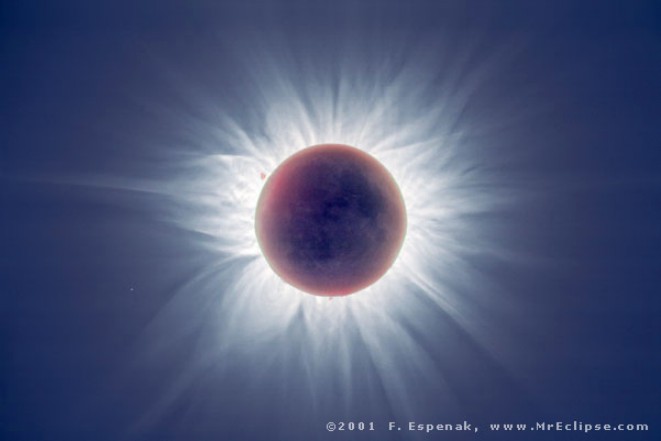
The corona extends from above the chromosphere to far, far
beyond the visible extent of the Sun.
Even though it is further from the
hot stellar interior than the chromosphere,
the temperature of the
very thin gas in this portion of the solar atmosphere
is even hotter: millions of degrees.
Most of the radiation emitted by the corona
is in the form of X-rays, which do not penetrate the Earth's
atmosphere.
Fortunately, there are several spacecraft which have
unobstructed views.
SOHO,
for example, can use its
LASCO
camera to take wide-angle pictures of the corona in X-rays.

Titanic explosions called solar flares
send hot gas shooting outwards into space at high speed,
as the movie below shows:
If the flare happens on a portion of the Sun facing the Earth,
the ejected material will take several days to fly through space.
Q: How long does it take light to travel from
the Sun to the Earth?
Q: If particles ejected from one flare take
3 days to reach the Earth, what is their
average speed through space?
Express in m/s, and as a fraction of the
speed of light.
When the energetic particles run into the Earth's atmosphere,
they can cause it to glow softly,
creating an aurora.
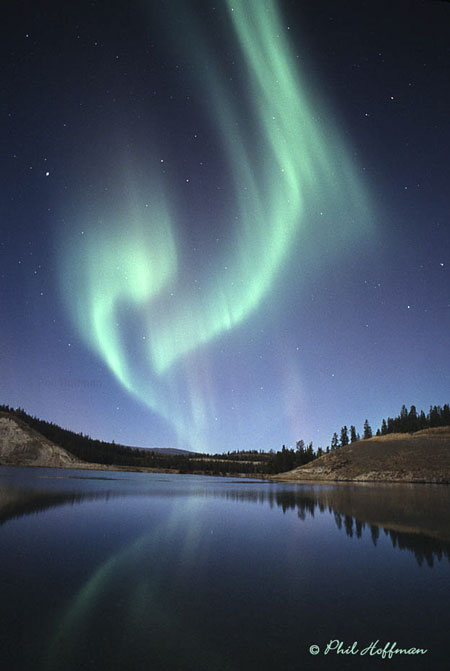
Image courtesy of Phil Hoffman
For more information
 Copyright © Michael Richmond.
This work is licensed under a Creative Commons License.
Copyright © Michael Richmond.
This work is licensed under a Creative Commons License.


 Copyright © Michael Richmond.
This work is licensed under a Creative Commons License.
Copyright © Michael Richmond.
This work is licensed under a Creative Commons License.










